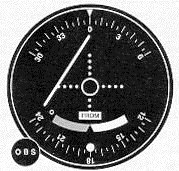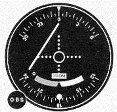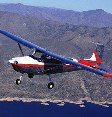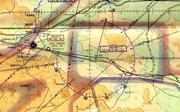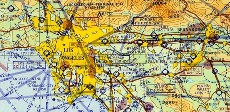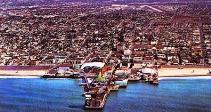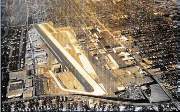|
Santa Monica Omni Internet
Version 2.0 Copyright
© 2012 by Paul Niquette. All rights
reserved. "Are you all right, Roy?" His gaze is fixed on the clouds ahead of us. The engine
labors into a climb.
Our little plane is banking to the left. "Roy, are you sick or what!" He was pale before take-off, now ashen. Roy seems
to be holding himself up with the control wheel,
staring, eyes glazed.
He turns toward me,
his lips are the color of bruises. "Paul." "Come on, Roy. You gotta
fly this
thing!" He nods grimly. The plane
banks more, still climbing. All at
once, Roy lets go of the control wheel and slumps to
the side. "What's wrong with Roy?" his wife asks from
the back seat. Continuing to turn left, we heave forward
toward the ground two miles below, speed increasing. The wheel
in front of me jerks toward the control panel. Grab it
with both hands and pull back. "Whoa,
goddam it!" The
engine growls.
I feel heavy in the seat. "I think he passed out, Mildred." The clouds ahead make a crazy angle with the
sky. A
quick glance at Roy.
His head is pressing against the side window. Now the
plane is nose-heavy.
I see why:
Roy's wife has leaned forward, reaching over
the front seat, shaking Roy’s shoulder. "Sit back, Mildred! Please!" "Maybe it’s his heart, Paul. We need to
get him to a doctor."
This is not how the flight was supposed to
be! Roy
passed out and next thing I know I am holding the
control wheel. As
Mildred moves back into her seat, I can feel the
plane coming into balance again. Bring the
nose up. "Can I just put his sweater over him?" “Not now.
Let me get this thing straightened out.” My wife is sitting beside Mildred. She must
be frightened.
To see her face, I have to turn around in my
seat. Annie
looks worried more than scared. Facing
forward again, I see the plane is banked to the
left. Why
the hell does it keep wanting
to do that? My
hands seem to be fighting each other. "Okay, Mildred. But take
it easy with the sweater."
Roy took his place in the left seat of the
plane and handed me a map. "Don't
call that a map," he said. "It's a
chart." Our wives were seated behind us, getting
acquainted. Roy and I had never socialized before. He frowned
at the gauges and started the engine. I examined
Roy's marks on the chart. He must
have laid out a dozen ‘check-points' along our
flight path from Santa Monica, California to Las
Vegas, Nevada.
I watched Roy steer the plane with the
rudder-pedals as we taxied to the side of the
runway. He
exercised the engine, then
mumbled something into the microphone. The
control tower answered promptly. "Eight-Three
Charlie, cleared for
take-off." Roy pushed in the throttle, a round knob in
the center of the control panel. The engine
took up the challenge and began pulling our little
plane along the runway. Roy eased
back on the control wheel and the concrete fell
away. While
climbing over the city of Santa Monica, Roy banked
the plane to the right. At
the shoreline, I turned around in my seat and
pointed out Pacific Ocean Park to my wife. I heard
her tell Mildred that we had taken the kids there
only a week ago. Roy's wife was something of a surprise to
me. Mildred smiled easily and spoke with precision. Quite a
contrast to her husband. Roy told
me that he never “bothered with no
colleges.” He
said his wife had enough education for the two of
them. The engine filled our little cabin with
hearty sounds of combustion. I was
curious about various items in the cockpit. Roy
shouted patronizing answers to my queries. I noticed
that he kept his feet flat on the floor. “Rudder
pedals are for sissies,” he explained. From time
to time, we threw barbs at each other. The fun might
last all the way across the desert. While
lighting up a filter-tip, Roy gestured for me to
take the control wheel in front of me. I shook my
head and pointed at the chart. "Are we
lost or what?" I asked. "Apple Valley Airport down there," said Roy.
"Nice runway, Roy. Why do you
suppose somebody painted `Barstow-Daggett' on it?" He banked the plane and squinted downward. "Did you leave your glasses home?" I asked. "Don’t need ‘em
until I start taking lessons." A meter-like instrument on the control panel
made me curious.
Roy saw my quizzical expression. "Omni," he
hollered. "For
navigating." "Do you know how to use it?" I asked. "Too complicated." Roy looked at his watch and checked off a
point on our course.
Realizing he had an audience, he frowned at
the ground below then back at his chart. I grinned
at my wife in the back seat. "Roy is a fine pilot, Annie. He's going
to use his omni to
figure out where we are." "Not in front of the girls." Roy changed heading slightly, and we flew on
without talking.
I noticed the needle on the omni had come alive. There was
a knob on the instrument, and I wondered what it
did. I
resisted the temptation to touch anything. Roy was
watching me. "Be
my guest," he said. I turned the knob and the needle moved off
scale; back again and the needle centered. Next time
I caught Roy's eye, I gestured at the omni and shrugged. Roy
pointed at a blue circle on the chart. "Omni
station," he said. Around the rim of the blue circle were a set
of numbers. Examining
the omni on the panel,
I saw numbers just like them. They were
printed on a dial that moved when the knob was
turned. I
gazed at the desert below and thought for awhile. All at once, I got it: The
numbers match the chart. When the
needle is centered, the location of the plane is
given by that dial.
As we flew along, the needle appeared to
drift off center.
By re-centering it with the knob, I could
take a new reading from the dial. I noticed
that Roy had previously drawn lines on the chart
from the center of the blue circle, like spokes on a
wheel. These
pencil marks intersected our course line and gave us
our position. While we were just cruising along, I was
able to figure out how the omni
worked. The
thing is quite intuitive. Now, I was
hardly qualified as an airplane navigator, but I had
just learned something mighty interesting. I had no
idea how useful this knowledge would be. The very
next day. "You're right, Roy," I said, turning away. "It's too
complicated." This
is not the story about a Saturday in Las Vegas. I
faintly recall a swim in the hotel pool and the
dinner show.
Al Hurt, Pete Fountain, and a fellow named
Vaughn Meader doing
impressions of our President. Events in the sky
the following day all but scoured my memory. Roy barely touched his dinner. He
chain-smoked and complained that his stomach was
acting up again.
Sunday morning, my wife and I met Mildred for
a brunch in the hotel.
She told us that Roy had not been able to
sleep and was upstairs in their room. Annie and
I exchanged glances.
Later, Roy Barnes, pale and gaunt, joined us
in the lobby. "Them places," he
said, nodding toward the casino, "stay open all
night." The weather had changed. It was
cloudy when we arrived back at the Las Vegas airport
that Sunday afternoon.
Roy went to a phone booth to talk with the
weather people.
He was frowning more than usual when he
returned, muttering disagreeably about headwinds and
low clouds in the Los Angeles Basin. My wife smiled at Roy. “Why don’t we stay
another night?” she said. “We can just call up the
sitter.” Roy shook his head and took a long drag on
his cigarette.
"Las Vegas is a bad place to get stuck in." The four of us took our places in the plane
without speaking.
The little Cessna swerved along the taxiway. After
take-off, the plane seemed to be barely climbing. Our flight
path ran parallel to a highway. Cars and
trucks were passing us. I razzed
Roy about that but got nothing in return. He allowed
the plane to bank then jerked it back upright, first
this way then that. "Do you have any idea which way Santa Monica
is from here?" I asked,
just to get something going. Roy crushed out a cigarette, his second
since take-off.
"Downdrafts," he grunted. The air was smooth but murky, not clear like
the day before.
After the better part of an hour, Roy
announced that we had reached 6,000 feet. He turned
the plane toward the hills southwest of Las Vegas. By this
time the ground below us had become a brownish blur. We could
see clouds everywhere.
Rocky peaks stood above them. Our wives settled into conversation. There was
something unsettling about this flight so far. Not a bump
in the air, yet the plane felt like it was
meandering all over the sky. Roy's chart was still folded up in his lap. I reached
over and took it, half expecting him to object. He did not
even notice. I
examined the course line we had followed the
previous day. It
was not hard to figure out the general direction we
should be flying.
I pointed to the compass above the
windshield. Roy
looked up and squinted. Surprised,
he banked the plane into a turn. When
we reached a southwesterly heading, I made a
straight-ahead gesture with my hand. Once
again, I expected something from Roy to the effect
that I didn't know anything about this business. Instead,
he stared off into space, as if he were waiting for
further instructions. The sun shone through the windshield chasing
shadows across the panel whenever the plane turned. I noticed
we were still climbing. Our
altimeter read 9,000 feet. I asked
Roy how high he had planned to climb. His eyes
closed and opened twice. Suddenly,
he pushed the nose over, making us catch our breath. If I
didn't know better, I would say Roy was intoxicated. Roy's hand trembled noticeably when he
reached for the trim control. I thought
of the omni. The needle was moving, so I centered it with
the knob and read the dial. I looked
at the chart and saw those blue omni circles. I had not
learned the day before how to tune in different omni stations. One blue
circle on the chart had an angle that looked
reasonable for what I guessed was our location. Beside its
name, Boulder City, was
a box with the numerals 116.7. Sure
enough, they corresponded to a set of digits that
appeared on the face of the omni
instrument. Without
my noticing, Roy must have tuned in Boulder City the
day before. That
number, 116.7, had to be the frequency of the omni station on the ground. I began to
think that it would be a good idea to keep track of
our progress – and not just to pass the time,
either. We
could not see the ground at all. Constant droning of the engine and the
propeller blast made it difficult to hear the
conversation in the back seat. The sky
had become a pure blue canopy above the clouds. The ride
was utterly smooth.
It was as if the four of us were merely
spectators to a cloudy scene projected outside our
window. Roy looks worse by the minute. Questions
begin parading through my mind. Could it
be the altitude?
Should I suggest we turn back? Even if we
do that, could Roy find the airport in all these
clouds? How
might I broach the subject of returning? Roy seems
strangely docile right now. We are climbing again. And
banking left. "Are you all right, Roy?" No more questions. Get the
plane level. See
to Roy in a minute.
Try to feel the controls. "Whoa,
goddam it!" Now
pull. Hands
tightening on the control wheel. There had been warnings. Only they
were not real enough.
The emergency even now is not quite real. No
physical pain.
We are neither freezing nor burning up. No
gunshots or explosions. No threats
from predators.
If this is real, nature is no help. Yet the
four of us are surely going to die. Maybe it's already over for
Roy. "How are you doing, Paul?" my
wife asked. Her question is oddly
reassuring. I
want to answer, but there are crucial things to do
here. What
are they? Get
the wings level.
Push down.
Find the airport. What
direction? Get
to a doctor for Roy. Look for a hole in the clouds. What
airport, for crying out loud? Get
control first.
Mountains down there. Climbing
again, dammit!
Any airport.
What if he is dead?
I won't look at Roy again. "Trying to get the hang of
it, Annie." Now a pain begins. I'm almost
grateful. Fibers
in my stomach.
Not a sound from the back seat. Stay
level. With
each passing minute, the fibers get tighter. It's real. The handful of flying lessons that I had
taken back in 1957 were from the left seat, with
my left hand on the control wheel. In
retrospect, that might not seem to be significant,
but it was. Trying
to take over from the right seat six years later,
I found that what little tactile memory remained
was firmly committed to my left hand, and my right
hand became useless – or worse. Why are my hands fighting
each other? Maybe
if I let go with my right hand. That’s
better. I
remember something Roy told me yesterday: the
elevator forces in the control wheel ‑‑ I can
balance them out with the trim control. But I have
to let go with my left hand to reach it. Adjusting
up – no down. Grab
the control wheel again. Level the
wings. Let's see, when did we take
off? Was
it 1:30 or 2:30?
Trim some more. Wipe my left hand on my
trouser-leg. Where
was I? The
time. "What time is it?" I asked
over my shoulder.
The fibers are tightening. I do have
a watch on my left wrist, but I do not want to take
my eyes off those clouds ahead. "Quarter after three." Annie's voice is calm. I am not
ready for arithmetic.
Suffice it for now that we have been up here
for more than an hour.
It took us two hours to get to Las Vegas
yesterday. We
must be near the half-way point. We will
not go back. I
need help, though.
Maybe the radio. First,
trim. "Mildred, can you reach the
chart for me?" It had fallen on the floor. She folded
it to show the desert area southwest of Las Vegas. As she
handed it forward to me, I thanked her. I was able
to take a quick look into her eyes. Mildred
was crying. This
is craziness! Where
do I come off thinking I can pilot this goddam airplane. With a
corpse on board.
So this is what panic
feels like. The
two women in the back seat ‑‑ they must be paralyzed
with panic. It's
all over but the screaming. And the
crashing. Yet, no screaming, except
from inside me.
Am I the only one with stomach knotted up and
pulling tight?
Don't they know what the hell predicament
we're in? Mildred knows. Real
tears. She
handed me the chart, though, as if it were the
morning newspaper.
Sadness, grief, but no screaming. Annie must
know. If
I can see Mildred's tears, so can she. With Roy
gone, what hope do we have? Still,
when I asked my wife for the time, she answered with
no more concern than if we were tardy to a dinner
party. One
of them ought to be up here in the front
seat instead of me. No screaming ‑‑ and there is
no crashing going on here either. If those
women are not going to panic, maybe I won't either. It's craziness, all right,
but I'm going to fly Roy's one seventy‑two. Thanks,
Ladies. Let
go, fibers. The plane is level; now we
must get pointed in the right direction. Only short
glimpses at the chart.
Looks like a heading of about 200 degrees
should get us into the Los Angeles Basin. The
compass above the windshield is indicating “W.” That would
be 270 degrees.
So we turn left,
and ‑‑ oh, for crying out loud, why is the compass
swinging around that way? The
turn is stopped, but the compass is still swinging. Obviously
you can't read that thing while the plane is
turning. I
must nurse it around a few degrees at a time using
the sun as a guide. "Figure we ought to head
about two hundred degrees." I called
back over my shoulder, trying to sound confident. I can use
all the help I can get. Mildred
has flown with Roy and must know quite a lot. "What do
you think, Mildred?" Probably should be worried
about altitude, too.
Some long time has passed since I tried to
read the altimeter.
To do so, I have to look over to the left, by
Roy's knee. I
do not want to stir up those panicky fibers. Looking
over there is like peering into a coffin. Right this
minute, I wish I could just go off and think about
our situation for a while. Coming around to a heading of
220 degrees, I leveled the wings. Close
enough. When
I hand the chart back to Mildred, I'll just take one
look at the altimeter. Over 10,000 feet. Plenty
high. That
settles it. I
won't think about altitude for now. The radio. Here’s the
microphone, but what do I say? Better
know where we are first. Back to
the omni. I need to
find the next omni
station that might help us? The name
in the circle is Daggett. The frequency is 113.2. Mildred handed me the chart
again. "Paul,
I'd say that 210 degrees is the right direction." Just have to let that go for
now. I
want to tune in Daggett. Set the
frequency digits like so. "Hey, what
happened?" I can't help shouting. On the
face of the omni,
there's a red flag that says OFF. "Something wrong?" my wife
asks. "Plenty wrong!" I wish I were able to hold
things in better.
I’m going to guess: when we are too far away
from the omni station,
the OFF flag appears.
We are not as far along as I thought -- and
we have swung around toward the sun. Get back
on course. The
situation has improved. The plane
at least is level.
I don't care to think what we would do if
there were even the slightest turbulence. Thanks to
Mildred, we are on some kind of a course. Sooner or
later, we shall be close enough to Daggett to use
the omni. Roy Barnes is never far from
my mind. His
face was ghastly, last time I looked. The women
have succeeded in calming me down, though. My grip on
the control wheel is starting to relax. "What's that mountain up
ahead?” my wife asks, pointing through the
windshield. “Above the clouds, there.” She must
think I really can fly this thing. I never
told her the whole story about my solo flight six
years ago. It
was a near disaster. "San Bernardino range,
Annie." It
was a guess. "Better stay away from
Ontario, Paul."
Mildred's voice is wavering but strong. "Roy
told me once that a lot of airliners come in over
Ontario, on their way to Los Angeles International." Mildred's words, "Roy told me
once" sounds like something you might hear at a
funeral. Whether
intended or not, she has set our priorities. No more
thoughts about getting him to a doctor. Our own
survival is all that counts now. The engine is running
steadily with its own kind of confidence. If that
really is the San Bernardino range and we are still
northeast of Barstow, then we can see hundreds of
miles up here above the clouds. We won't
run into any mountains. "We're pretty far north of
Ontario, Mildred."
I forced myself to study the
altimeter. How
curious, we have climbed to over twelve thousand
feet. My knowledge of aviation that Sunday was elementary, mostly learned
from books. Hypoxia
produces physical symptoms that include headache,
nausea, and shortness of breath. Most
subtle – and probably worst for the safe conduct
of flight – is euphoria. The OFF flag on the omni has disappeared
sometime while I was not looking. It is
replaced by a flag that says TO. Center the
needle with the knob and read the dial. Look at
the chart. Compare. Something
is wrong. We
cannot possibly be where that dial says we are -- beyond
Daggett. We
have been in the air two hours, long enough to be
over the ocean.
Look down.
Nothing but clouds. San
Bernardino Mountains?
Shit! Those
are the islands off Santa Barbara! Look at the chart. There is
an omni station at
Ontario, tune in that one. It is
112.2 on the frequency digits. Turn the
knob, the needle centers, and the flag . . . the
flag says FROM.
The dial reads 20 degrees, which does put us
northeast of Ontario.
And over land.
I took a deep breath. That must
be the answer.
The flag must say FROM. Otherwise
the dial lies
to you. Probably
not the whole story, but it will do for now. Problem
solved. Annie is consoling Mildred. They are
talking in low tones.
I have no time for grieving. Most
important for now, I have to keep the plane pointed
on its course of 210 degrees. Roy went
out, doing what he loved best. Hell,
flying an airplane is something I have always
dreamed of doing, and here I am doing it. Seems I have figured out the
FROM flag on Roy's omni. Hooray for
that. Tune
in Daggett again.
Twist the knob all the way around until the
FROM flag appears.
There we are:
East and north of Daggett. Don't know
how far, but I know more about omnis
than I did yesterday.
Actually, we have not even come to
Daggett yet. Glad
I was able to keep that nonsense about being over
the ocean to myself.
We are not even half-way there. I forgot
about that long, slow climb and those "downdrafts."
Mildred is sobbing. Wish I
could help her as much as she has helped me. Not
possible. Annie
is doing her part. If Roy had a heart attack or
stroke, we should have tried to take him to a
hospital immediately.
Now that I realize how slow our progress has
been, I see that it would have been better to turn
back right after I got control of the plane. The
authorities will probably scold me for not turning
back. It
may not make sense to worry about what anybody
thinks. I
can't help it, though.
Thing is, I thought we
were farther along.
That ghastly look on Roy's face ‑‑ he was a
goner. I
shall have to live with the decision not to turn
back for the rest of my life. How long
will that be
anyway? Two hours now, or maybe
longer: I wonder how much gas we have left. They will
want to know on the radio. I
noticed the fuel gauges yesterday. They are
near the top of the cabin on either side of the
cockpit. The
one here on the right indicates less than half full. The one on
the left reads… the same. Another
problem. When I ease my grip on the
control wheel, the plane almost flies itself. Finally we
have passed Daggett and the town of Barstow
somewhere down there below the clouds. The air is
still smooth. Better
take another reading from the omni
station at Ontario.
The desert is behind us. According to the chart, there
are several airports nearby: San
Bernardino, Riverside.
But to get to them, we would have to be
"talked down" like in the movies. Meanwhile,
I am sitting up there at 12,000 feet solving
problems all by myself. At the time of the flight, radar was one
of my technical specialties, dating back to
research for the FAA in the earliest applications
of surveillance radar in air traffic control. Something
I knew well: ‘radar rooms’ were primitive as hell
in the early sixties. As incompetent as I was as a
pilot, I did not welcome the idea of anybody in a
radar room trying to rescue us. Studying the chart, I
concluded that we would soon be over the "Cucamonga
Wilderness Area."
If we are going to get talked down, why not
wait until we get to Santa Monica? After all,
Santa Monica was where we parked our cars. Our main worry must be
mountains. On
the chart, they are all around us. The ocean
looks much more inviting. What about
a landing into the ocean? I had
pleasant visions of flying off the edge of the coast
into the blue part of the chart and letting down
gradually to a soft splash. Like
diving into a pool.
Annie is a strong swimmer and so am I. We could
both help Mildred keep afloat if necessary. And it
doesn't matter about Roy. The water
will not even be cold, was my thought. Through no effort that I can
remember, the plane has been drifting down to lower
altitudes. Nearing
the San Fernando Valley, now, and flying at about
9,000 feet. The
engine is tending to business, keeping up its steady
drone all the way. While my eyes are fixed on
some parcel of clouds on the horizon, my mind's eye
gives substance to the coming scene: blind descent
through the overcast, violence of the water landing
as the wheels slam into the waves, sound of metal
crunching ‑‑ not like diving into a pool at all. With the
renewal of that clutching, fibrous pain in my
stomach, I know that reality is close at hand. “Diving
into a pool”? No
more wishful thinking, thank you. Our
problem is not running into a mountain, it will be
getting trapped inside a sinking airplane. Even up here in the clear
air, it has been a constant workout trying to keep
us going straight.
To avoid letting the plane bank itself into a
turn when you cannot see beyond the propeller, must
be a bitch! You
surely do not trust that stupid magnetic compass. What
can you
trust, “the seat of your pants”? Not
according to the book I read. Aviation books explain that for stable
flight inside a cloud, the pilot must rely on
gyroscopic indicators. Roy’s
panel had only one, the most rudimentary
gyro-instrument, Needle-and-Ball, which was a
subject not covered in my flying lessons six years
earlier. "There's a hole in the
clouds!" My
shout breaks a long silence. "See it?" Not a
hole, actually.
It’s the top of a mountain sticking up. Something
is glinting in the sun. According
to the last measurement I took on the omni dial, we should be
north of Pomona.
Seems like nearly another hour has gone by
since Daggett.
"Mount Wilson!
There’s the observatory?" That means we are quite far
north of where we ought to be. After probably three
hours, I have yet to try and contact anybody on the
ground. I
might be able to do that now, since I know exactly
where we are. They
will ask me how much gasoline we have left. Yesterday
we flew for about two hours. Per
agreement with Roy, I picked up the tab for
refilling the tanks in Las Vegas. They were
about half full.
So maybe we took off with enough fuel to fly
for about four hours.
So, I must tell people in the radar room that
we have an hour's worth of fuel left. Our
altitude ‑‑ they will want to know that too ‑‑ is
about 6,000 feet.
Been doing some more descending, I see. OK, radar room, I'm ready to
talk. I
picked up the microphone. Better
listen first. The
cabin speaker is over on the left-hand side of the
plane. Turn
the volume control up.
Coming from the Ontario omni
station is the voice of a man reading a weather
report. I
can barely understand his words. Wind
directions, cloud conditions, temperatures,
dew-points. Then,
"Long Beach closed; Torrance closed; Hawthorne
closed; Los Angeles closed; Santa Monica closed." "Santa Monica is closed!" The words
explode out of my mouth. We have to
go into the ocean.
We have
to. I hung up the microphone and
tuned in the Santa Monica omni
station. That's
110.8 on the frequency digits. The FROM
flag pops right up.
A clatter on the speaker. Now, a
recorded voice.
" . . . Santa Monica Omni . .
. Santa Monica Omni . . . " The dial reading from Santa
Monica is 30 degrees.
The fuel gauges now read "NO TAKE-OFF," less
than quarter tanks.
" . . . Santa Monica Omni . .
. Santa Monica Omni . . . " Can't talk to a goddam recording.
Suddenly Annie cries out,
"There's a big airplane down there!" Looking back over my right
shoulder, I can see Annie looking down. From her
shout, you might think we were about to have a
mid-air collision.
Banking the plane to the right, I can see a
break in the clouds.
Big airplane, all right, but it is not
flying. It’s
a Lockheed Constellation parked on the ground. Level the wings. Let that
compass settle down again. Quick look
at the chart. "That has to be the
Lockheed-Burbank Airport!" For the second time, I have a
confirmation of our location. Bless you,
omni! Should
I turn back and try to make it through that hole? Tilt
right, look again.
Gone. The hole
in the cloud has vanished. " . . . Santa Monica Omni . .
. Santa Monica Omni . . . " If I live to be a hundred
years old, I shall always remember the exact sound
of a flat, recorded voice, repeating those words
over and over as our little airplane cruised above
the clouds on a Sunday afternoon in April, 1963. Soon I must push the control
wheel forward to point us down into those clouds. The sun is
shining up here, and I do not want to leave this
clear blue sky.
No way to put it off, though. Since
we are north of where we ought to be, I must angle
to the left. Altimeter
now shows 5,000 feet.
Not much fuel left. Got to
hurry. The
hardest part is yet to come. The fibers
are back. The hills north of Santa
Monica are still ahead. Our only
hope is to head for the coastline and let down over
the water. I
need a "marker," something to tell me when we are
actually over the water. One more
look at the chart.
The omni again
‑‑ set up the omni dial
to read 270 degrees from Santa Monica. That marks
the coastline near Malibu. When the omni needle comes to the
middle, I will know ‑‑ this time for sure ‑‑ we have
passed the shoreline, even though I can't see it. Then I
must simply force
myself to take us down through the clouds. " . . . Santa Monica Omni . .
. Santa Monica Omni . . . " "Got your safety belts
fastened back there?" It is happening. The omni needle is moving toward
the center. The
decision is made.
Push the nose down. "Hang on. We are
going down." The plane is not banking
around like it did when I first took over. If I can
just relax a little and hold absolutely still… Picking
up speed. The
control wheel is getting stiff. Some
turbulence as we sink into the tops of the clouds. The pitch
of the engine is increasing. I want to
pull back. " . . . Santa Monica Omni . .
. Santa Monica Omni . . . " Suddenly, the horizon is
gone! For
a moment I am stunned, continuing to stare straight
ahead. It
is like barreling along inside a milk bottle. Cannot
allow the plane to tilt over into a turn. Cannot
allow myself to think about anything else. " . . . Santa Monica Omni . .
. Santa Monica Omni . . . " "Where's the airport?" "Don't talk to me now,
Annie." Banking left ‑‑ I feel it all
through my body.
Turn the control wheel to the right. Back to
the middle. Now
to the left again.
A few bumps in the air. Outside it
is becoming steadily darker. Seems
like the plane is turning right. The
compass says we are not turning at all. God, but
it feels
like we are turning right! Believe
the compass. Can't. Move wheel
to left, tighten my grip. No, now we
are definitely
turning left. The
compass has gone berserk. Bring it
back to the right again. The sky is getting darker. A glance
at the altimeter.
Zero thousands ‑‑ 500 feet! Only 500
feet above sea level.
Now blue-dark
from below. The
ocean! I
can see the water!
Right under us.
Rolling waves. " . . . Santa Monica Omni . .
. " I feel like letting out a war
whoop. Me
and this old one seventy-two ‑‑ we know each other. I can see
ahead and to the right. The
shoreline should be on the left. There it is, bank to the left. We did do some
turning in the clouds.
Pull up.
Not going to dive into that water yet if I
can help it. Low
on gas, but we can make it to the beach. Looks like
a mile away. Something is out of place! My mind is
racing. What? Going down
again, pull back.
No lower or we'll hit the water. " . . . Santa Monica Omni . .
. " In all this frantic activity,
as we came through the clouds, I was so totally
consumed, fighting the turns. Something
sure as hell is out of place. It’s Roy. He moved! Can't look at him right now. Got to
watch the shoreline.
Approaching at an angle to our flight path. Maybe one
quick look. No
shit. He is struggling to sit up. "Roy! You son of
a bitch! You’re
alive?" With a gasp, Mildred reaches
forward for Roy.
Looking out ahead, I see some big structures. Nose heavy
again. "Take
it easy, Mildred!"
Mildred is holding Roy's head
with both hands. "He must have passed out back
there," I exclaimed.
The structures at the
shoreline – that’s Pacific Ocean Park. Just like
yesterday ‑‑ except we are a damn sight lower now.
Sobbing from behind me; Annie is crying now. Finally. Got to know if Roy can take
over. "How is he, Mildred?" "Better get him to a doctor." That means it’s still up to
me. My
old friends, the gut fibers, are coming back in full
force. Pacific
Ocean Park is passing just below us. Heading
inland now over downtown Santa Monica. Forget the
gasoline; I think I'm going to find the airport. Sit there
and watch,
Roy, damn you! " . . . Santa Monica Omni . .
. " Houses and buildings. Power
poles and palm trees.
Too close, pull up. Mist on
the windshield.
Can't go any higher or we'll be back in those
clouds again. The
runway suddenly appears dead ahead. "There's
your airport, Annie!" We're almost on top of it. Turn
slightly. I
see the control tower.
Too fast!
How do we slow this thing down? The
beginning of the runway is right in front of us. We're at
an angle. Push
down and turn.
Almost lined up. Really low
now. " . . . Santa Monica Omni . .
. " Damn it, I can't reach the
throttle with my right hand without messing us up! "Roy, cut the power!" He struggles forward with
Mildred's help.
Roy's hand closes slowly on the throttle. "Now, Roy!" For hours, that little engine
has roared faithfully for us. Suddenly,
except for mild sputtering, it is quiet. Roy has
collapsed again back into his seat. Here comes the runway. This is
going to be interesting. Some faint
memory from more than six years ago has me heave
back on the control wheel. The forces
get weaker as the plane slows down. We sink
suddenly, quietly. Bang! The wheels
hit the pavement with a squeal and we bounced. The sunvisor drops in front of
my eyes. Push
it up. The
plane has gone crooked. Turn ‑‑
but the control wheel is useless. The front
wheel hits the ground and shudders. A short
stab at a rudder pedal. Veering to
the right. Other
pedal! A
cheer from the back seat. Slowing,
slowing. Off
the runway. Stopped. " . . . Santa Monica Omni . .
. Santa Monica Omni . . . "
Epilog The plane came to a stop on pavement beside
the runway. I
turned off the ignition. Mildred
continued to support Roy’s head from behind his
seat. I
opened the door on the right side of the plane,
climbed out, and held the door for my wife. She jumped
to the ground and flagged down a passing fuel truck
and told the driver to call an ambulance. I stood
under the wing and helped Mildred with Roy. We laid
him across the front seat. In a matter of minutes, we heard the siren
approaching the airport. Paramedics
loaded Roy onto a stretcher and lifted him into the
ambulance with Mildred by his side. His face
was covered by an oxygen mask. That was
the last time I would ever see Roy Barnes. Or so I
thought. My wife learned from Mildred that Roy was in
the hospital for several days. The
diagnosis was hypoglycemia. His
condition was aggravated by hypoxia and anemia, but
his heart was fine.
Weeks later, Mildred told us that their son
lived in Carlsbad near San Diego. She had a
new job there, and Roy was talking about setting up
a TV repair shop in Oceanside. With each passing day, I intended to call
Roy but felt too awkward. That
Sunday was an immense experience for me, comparable
perhaps to survival in mortal combat. I figured
Roy would be embarrassed if not apologetic. More than
once I picked up the phone, thinking to ease the
tension with a wise crack, “Thanks for letting me
fly your plane, Roy.”
But I never dialed his number. Then one
evening the phone rang. The voice
was familiar enough. “Got a gift for you, Paul.” “Bet I know what it is.” Back when we were working together, Roy
bragged about his charter subscription for Playboy. “Got all
twenty-four issues,” he had said. “Arlene
Dahl, Sophia Loren – starting with the December 1953
issue with Marilyn Monroe on the cover.” On the
phone Roy told me that he had found the collection
while packing for his move to Carlsbad. “Hell, you need them magazines more than I
do,” he said. We set a time and I dropped by his house in
Culver City. Roy
was waiting for me in the front yard. I shook
his hand firmly and looked long into his eyes. He seemed
quite robust, but I made no comments about his
health. I
noticed he was not smoking. We
exchanged small talk, with no mention of flying,
until Roy told me that he had sold Eight-Three
Charlie to a flying club. I said
that I was looking for a plane to buy, “With two omnis in it.” He nodded
without smiling.
Taking the gift from Roy seemed like the
best thing for both of us. I thanked
him, then made an excuse for quick departure. We loaded
the box in the trunk of my car and I started the
engine. Roy leaned into my open side window and
frowned. “That
was the worst goddam landing I ever seen.” |
